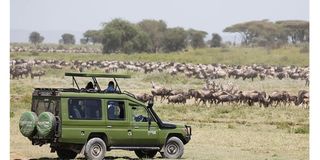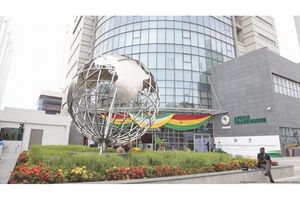Revealed: Factors behind tourist flow in Tanzania

Tourists admire animals in Serengeti National Park. PHOTO | COURTESY
What you need to know:
- The sharp rise in the number of tourists visiting Ngorongoro and other attractions has been attributed to a number of reasons, including the lifting of Covid restrictions in source markets and impact of The Royal Tour documentary
Arusha. It’s boom time for Tanzania’s tourism industry if what has been going on at the Ngorongoro Conservation Area (NCA) in recent weeks is any guide.
Long columns of vans carrying the visitors into one of Tanzania’s most popular tourist destinations are a daily feature, with NCA staff having to work overtime to cope with the numbers.
This is the scenario at the Lodoare Gate, which is the busiest entry point into the (NCA).
Although this is traditionally the high tourist season, relaxation of Covid-19 restrictions in source markets is also said to have boosted tourist numbers seen at the NCA.
The impact of The Royal Tour documentary has also been mentioned as a factor.
Lodoare is an entry point not only to the NCA, but also the world-renowned Serengeti National Park.
The NCA and Serengeti account for about a third of tourists who visit Tanzania annually.
“The tourists are back,” said a Ngorongoro Conservation Area Authority (NCAA) official as visitors disembarked from vans.
This, he said, was an encouraging sign, bearing in mind that visitor numbers plunged by about 60 percent after the pandemic set in.
Clearance of vehicles from the gate, which is located near the famous Ngorongoro Crater, leads to another scenario.
That is increased vehicular traffic on the main route cutting through the NCA all the way to the Serengeti.
NCAA officials say they were working to ensure everything was in place to handle the rising number of the visitors.
“Tanzania should be on the world map with regard to tourism,” said Mr Joshua Mwankunda, an NCAA manager in charge of geoparks.
Tourism stakeholders in Arusha attribute the influx of the visitors to easing of travel restrictions in the source markets abroad.
Government officials, on the other hand, link the increasing number of the visitors to the recently launched The Royal Tour film.
The Tanzania National Business Council (TNBC) has projected a 6.2 percent increase in arrivals this year.
Last year, the country received about 922,000 foreign tourists, up from 620,000 at the height of the pandemic in 2020.
“Tourism will remain the fastest growing sector of the economy,” said TNBC executive secretary Godwill Wanga.
It is further projected that the sector will contribute up to 19.5 percent of GDP.
Signs of a quick recovery are evident. Between January and May this year, 458,048 foreign tourists jetted in,a 44 percent rise compared to 2021.
The number of tourists who visited Tanzania in 2019 climbed to 1.5 million, generating $2.5 billion for the economy.
Mr Sirili Akko, the executive secretary of Tanzania Association of Tour Operators (Tato), admitted that some of the visitors currently flocking to the sites had postponed their trips in 2020.
However, he said efforts being made by the government to aggressively promote the sector would boost the numbers and investments.
According to him, The Royal Tour film has added value in that it has opened gates for new investments in addition to the tourists.
The increasing number of tourists somehow correlated with the hotel bookings in Arusha, the country’s safari capital.
Ms Irene Sisamo, the sales and marketing manager of Kibo Palace Hotel, told The Citizen recently that bookings at the facility had risen by 50 percent.
There had also been increased landings by the global and regional carriers at Kilimanjaro International Airport (KIA).
For instance, in June, this year, there were 921 flights arriving at the airport, which is 217 flights per week or 31 flights per day.
Currently, there are 17 airports in eight countries that have direct flights to KIA.



